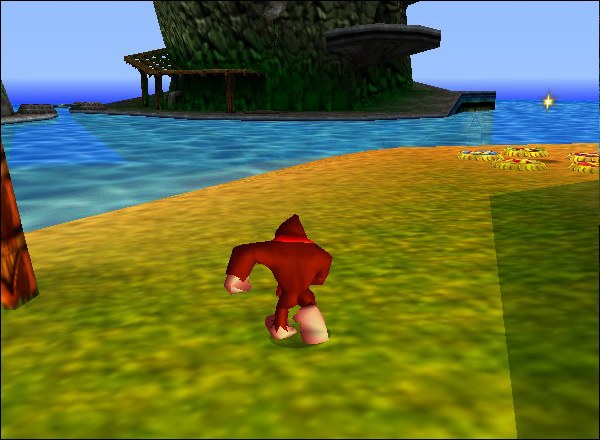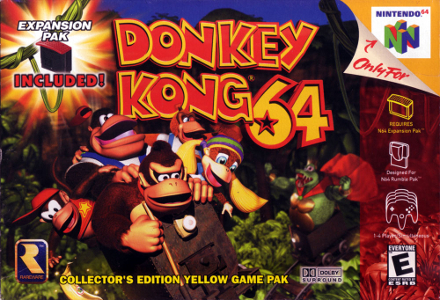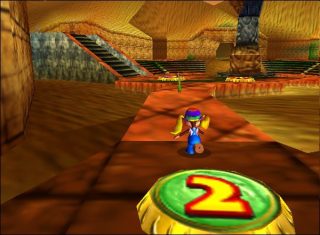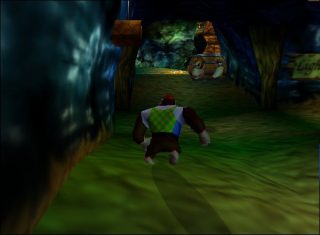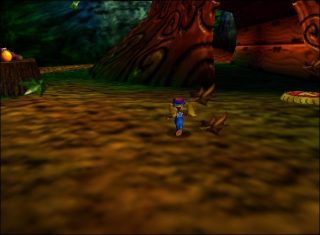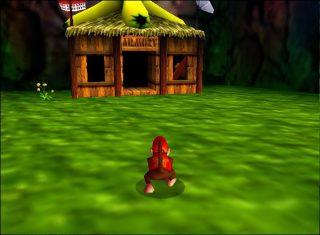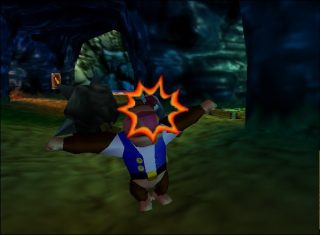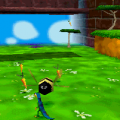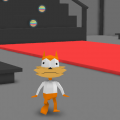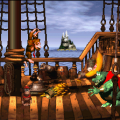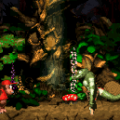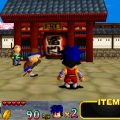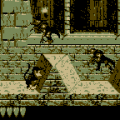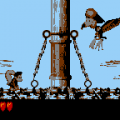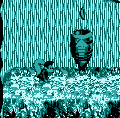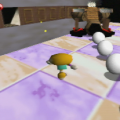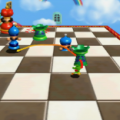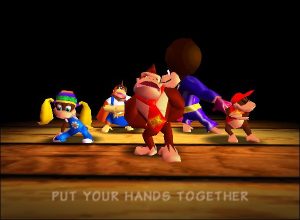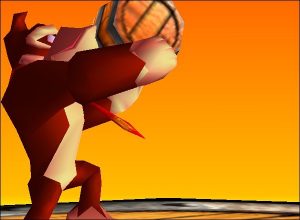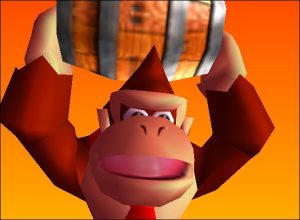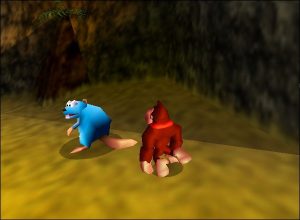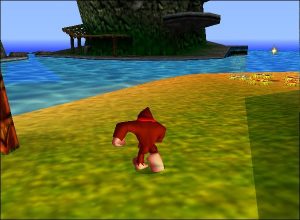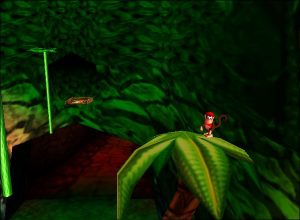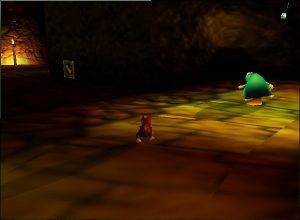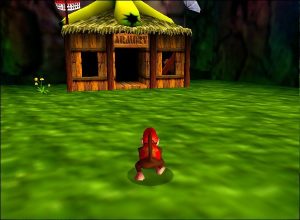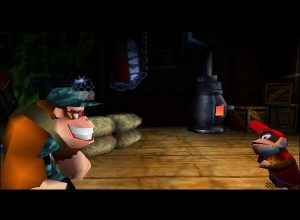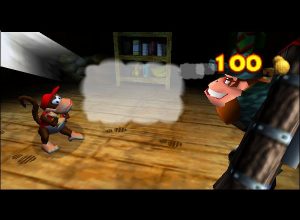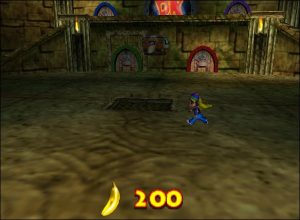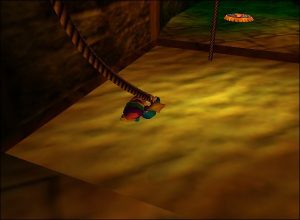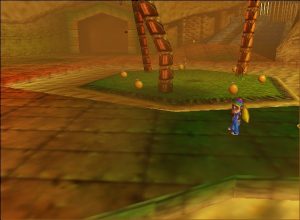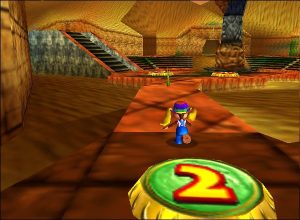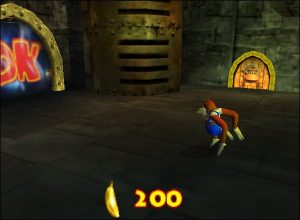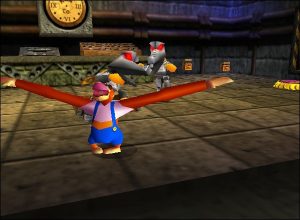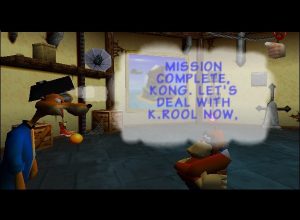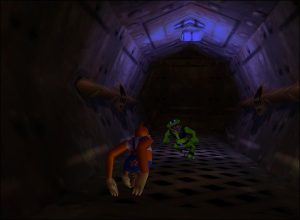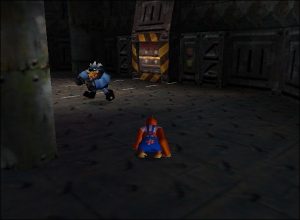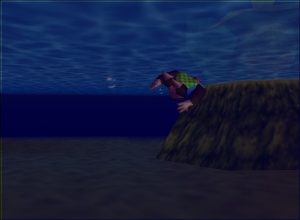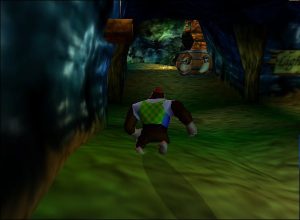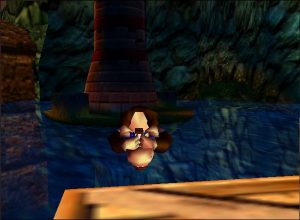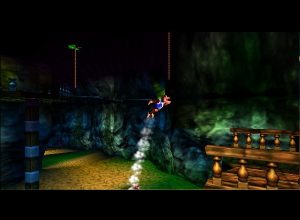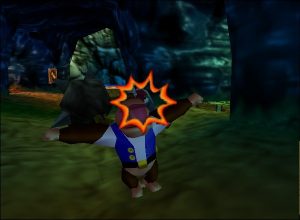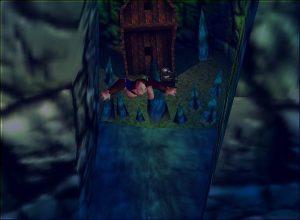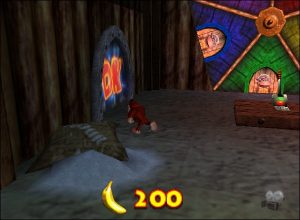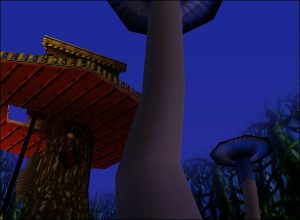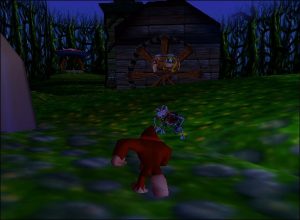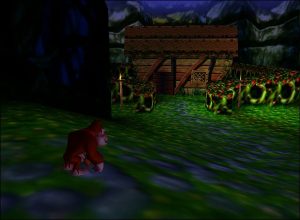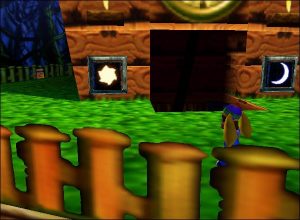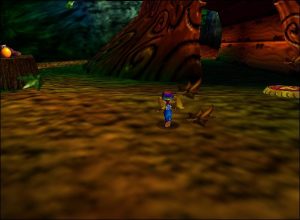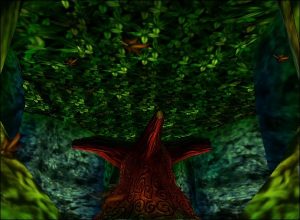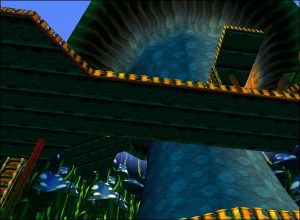And so, 3D reigned and the magic of the 16-bit era was swept into memory—and Donkey Kong Country along with it. Nintendo gave us the N64, with its 256 megabit cartridges, graphics expansion paks, and ridiculous controllers designed for 3-armed aliens. From the get-go, Nintendo wanted to take us into a new era, shelving a number of its legendary franchises. Rare got to work creating new IPs to great effect with games like Goldeneye and Banjo-Kazooie. Finally, at the very end of the 90s, and three years since its last outing on SNES, Rare gave us the contemporary Donkey Kong game that many had been clamoring for. The end product was a game with a bit of an identity crisis, and understandably so considering the era in which it was released: an era where we were still awkwardly testing the waters of three-dimensional gaming.
Super Mario 64 was the first 3D game that really gave an impression that the people who worked on it knew what they were doing. Thus, when any other developer dared to venture into the polygonal realm, they naturally used Super Mario 64 as a template. So that’s how we got Rare’s first platformer on N64: Banjo-Kazooie, which follows Super Mario 64 to a fault—start off in a hub world by which you enter a series of more specifically designed and thematic worlds. Each world has a set of collectables that must be acquired to make other worlds accessible.
Donkey Kong 64 follows this template as well, but something was lost along the way.
DK64 starts with DK Isle in crisis. K. Rool has built an immense battleship and is bombarding the Island, sending forth a legion of goons who have enslaved all the members of the Kong clan except Donkey. Now, DK has to free the other four Kongs he’ll rely on to navigate the complex network of labyrinths that twist and turn through both DK Isle and K. Rool’s ship.
But it’s not that simple, of course. DK is cut off from most of the Island by sentries K. Rool has sent to impede DK’s progress, and the only way to get rid of them is by appeasing them with your Golden Banana collection (Golden Bananas are the Stars or Jiggies of DK64, if you will). But DK is also limited in his ability to collect bananas due to his lack of particular techniques that cut him off from a great deal of the Island’s worlds. Some of these abilities can be purchased from the various NPCs who’ve set up shops all over the world. But other abilities belong exclusively to the other Kongs, so he’ll need to save them as soon as possible if he wants to progress very far into the Island’s depths.
All this gives DK64 a very dynamic sense of progression, and on paper, it’s brilliant. Which makes it all the more tragic that DK64 runs so far amiss of its goal of becoming one of the greatest platformers of its day.
The first problem, or at least the one most immediately apparent, is the aesthetic. Gone is any trace of the dark, brooding, epic sensibility its predecessors had. Now, we need cutscenes and dialogue and a narrative, and DK64plays out more like a Saturday morning cartoon, and not a good one. There’s loud, obnoxious silliness at every turn, from incessantly giggling faeries, the overly animated and desperately “comedic” antics of the aforementioned NPCs, to the dancing, idiotic lunacy of the game’s resident gatekeepers: the giant, mutinous Kremling, K. Lumsy, and the belching, swaying pig and hippo duo Troff ‘n Scoff. And then there’s the DK Rap – that’s become legendary over the years. Legendary for the same reason that movies like Showgirls and Troll 2 still get screened in theaters all over the country. The lyrics go something like this, describing Donkey Kong himself:
He’s the leader of the bunch, you know him well,
He’s finally back to kick some tail,
His Coconut Gun can fire in spurts,
If he shoots ya, it’s gonna hurt!
He’s bigger, faster, and stronger too,
He’s the first member of the DK crew!
But it takes more than a dumb presentation and some questionable design choices to ruin a game. The flaws that strike DK64 in its tender bits are the flaws brought on by its well-meaning but fundamentally malignant gameplay structure.
Since the beginning, the series has been moving towards the ever evolving “Collectathon”. Well here is where it finally comes to a head and bursts, like a pulsating zit on the forehead of 17-year-old fry cook who splashed the oil one too many times.
So, you already have the Golden Bananas. They’re the Stars, the Jiggies, whatever. We’d come to expect those from 3D platformers by then. So what? It’s a mechanic that worked and just because it’s been used before doesn’t make it terrible. Every Kong has four Golden Bananas to collect in each world, and the Golden Bananas are used to access other worlds. To get the Golden Bananas, you either need to find them laying around the world, or you enter bonus barrels (as seen in the previous DK games). But rather than taking you to a brief and unique bonus game tailor made for the stage that the bonus barrel is found in, the bonus barrels in DK64 lead to some of the most egregiously tedious mini-games ever devised, and you have to play the same handful of them over and over and over again. These mini-games consist of things like taking a giant fly swatter and trying to kill a fly or playing a slot machine. No quirks, no gimmicks. You just play a slot machine.
To gain access to new areas of DK Island so that you can collect even more Golden Bananas, you need to visit K. Lumsy. From the outset of your adventure, you meet this giant Kremling, who’s been locked up by K. Rool, and each one of K. Rool’s generals is holding one of the nine keys to his prison. Each time you fight a boss, you win one of the keys. Each time you bring a key to K. Lumsy, he jogs in place and makes a lot of annoying noises (like everything else in this game, mind you), and the seismic racket he kicks up causes aspects of the Island to change, revealing new parts of the hub world that grant you access to the actual stage entrances (which are guarded by the sentries that want to see your Golden Bananas, remember?).
You can’t just up and fight the bosses who are holding the keys. The bosses are locked behind doors in each stage. Now here’s where things get classic-adventure-game levels of convoluted: the doors are locked. But the keys are in the locks. But the doors are huge, so you can’t reach the locks. In front of each door is a counter-weight system. Troff, a giant pig, and Scoff, a giant hippo are trying to help you get the door unlocked. The problem? Scoff isn’t heavy enough to lift Troff to where he can reach the key. So what do you have to do? You have to feed the god damn hippo a ton of bananas, which are spread all the over every world, so that he gets fatter and can lift Troff higher.
Okay, so in case you’re having trouble keeping score, at this point we’re looking for Golden Bananas to enter the various worlds (four in each stage, per Kong), Boss Keys to reveal the entrances to the worlds (one in each stage), and regular Bananas to feed the demented animal bastards that give you access to the bosses (100 in each stage, per Kong). That’s a lot of stuff right there. That’s gotta be it, right?
Wrong. You can’t just blaze around the stages collecting crap like an excited child hunting for eggs on Easter Sunday. Your access to each stage is very restricted until you purchase certain abilities from the shopkeepers spread throughout each stage. There’s Cranky, who sells you potions that give you new special moves. There’s also Funky, who sells you weapons you need to use at certain spots in the stages which unlock previously inaccessible areas. And then there’s Candy, who sells you musical instruments that more or less do the exact same thing the weapons do.
But they don’t just give you all this stuff. To collect this stuff, you need to collect something else! Enter Banana Coins. You need to collect these beautiful, rotating discs of multi-colored garbage to be able to barter with the shop Kongs.
So say you do all of this, and you finally get to the last stage. You’re ready to beat this jerk and move on with your life. Well, about halfway through the last stage, you find out you need these things called Battle Crowns, one of which is in each world. To get them, you need to find this magical pad that warps you to an arena somewhere. In this arena, you need to survive and unending onslaught of enemies for a certain amount of time.
But that’s not all! If you want to see the true ending, you need to get 101% completion, and to do that, you also need to collect Blueprints. There’s one Blueprint in each stage, per Kong. To get it, you need to defeat these powerful, hulking enemies called Kesplats, which drop the Blueprints upon dying. Then you take the Blueprints to Snide, a weasel that also has a booth set up in each world, who in return gives you… more Golden Bananas!
Finally, you also need to catch Faeries. There are two Faeries in each world. And to “catch” them, you need to take a picture of them. To take a picture of them, you need to collect film, point your camera in the general location of the fairy, and wait for a smiley face to pop up on screen.
By the end of the game, if you’re going for full completion, you’ll have collected 201 Golden Bananas, 9 Boss Keys, 4000 regular Bananas (every time you get 75 regular Bananas with a Kong, you get yet another collectable called a Banana Medal, by the way), 20 Faeries, 10 Battle Crowns, a Rare Coin, and a Nintendo Coin.
None of this, in spite of all of these indications, ruins the game. What ruins the game is that in the process of inundating you with all this ridiculous nonsense, Rare forgot to make a platformer. Nothing you do in this game is particularly spectacular. There’s none of the thrill of long-jumping across bottomless chasms in Hazy Maze Cave or riding a Koopa Shell across Shifting Sand Land. The stages in DK64 are pretty flat, dull, and mainly just function as storage space for the unending cornucopia of collectables. The design of the stages too, while being graphically impressive in a rote sort of way, is pretty stunted. The only truly arresting world, Fungi Forest, is not surprisingly taken from the cutting room floor of Rare’s previous game, Banjo-Kazooie. And the music, composed by Grant Kirkhope, is not without its clumsy charm, but it just feels like a big empty hole where Dave Wise used to be.
At a certain point in playing DK64, you come to a sudden realization that you’re not doing this for fun. This is work. This isn’t a game, it’s a part-time job. It’s less like Super Mario 64 or even Banjo-Kazooie and more like Animal Crossing, which, at this point, hadn’t even been released yet.
Is that a crime worth condemning the game for? Perhaps. On some level, DK64 is still kinda fun. That may be masochism, but somewhere underneath this obnoxious, silly, labyrinthine scavenger hunt, there’s a good game. But those moments, especially in replaying it now, are pretty RARE (waka waka).
Apart from chipping in to help with the reworking of the handheld ports of the SNES franchise, DK64 would be the last time Rare would touch Donkey Kong. Not long after their impressive reign on N64, Rare jumped in bed with the handsome young newcomer to video gaming, Microsoft, and on their Xbox hardware, they produced an impressive line of… well… pretty much nothing.
Donkey Kong himself would be relegated to guest appearances in other Nintendo franchises, but the days of starring in his own epic platformers were pretty much over. Until half a decade later, that is.
Rare included a few old school homages in the title, at least. The arcade version of Donkey Kong is included in the cartridge and is found in the Frantic Factory level. What’s interesting is that it’s the arcade version of the game, complete with all four levels, rather than the NES version that Nintendo keeps recycling on most of their Virtual Console releases, which is missing one of the levels. By collecting enough Banana Medals, you can also unlock a port of Jetpac, Rare’s first video game, which was originally published on the ZX Spectrum. Maybe nothing of interest to Nintendo fans, but it’s a good bit of history.
Donkey Kong 64 was the first game to require the usage of Expansion Pack module for the Nintendo 64, which expanded the system’s RAM capabilities. Since its use is mandatory, it was included for free with every package. According to commentary by Rare’s Chris Seavor, there were some fatal bugs that the developer was unable to iron out, and the only solution to keep the game from crashing was to add more RAM.
